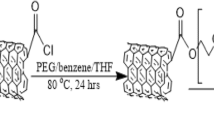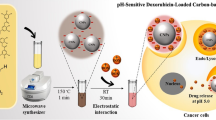Abstract
Paclitaxel (PTX) is one of the most important drugs for breast cancer; however, the drug effects are limited by its systematic toxicity and poor water solubility. Nanoparticles have been applied for delivery of cancer drugs to overcome their limitations. Toward this goal, a novel single-walled carbon nanotube (SWNT)-based drug delivery system was developed by conjugation of human serum albumin (HSA) nanoparticles for loading of antitumor agent PTX. The nanosized macromolecular SWNT-drug carrier (SWNT-HSA) was characterized by TEM, UV–Vis-NIR spectrometry, and TGA. The SWNT-based drug carrier displayed high intracellular delivery efficiency (cell uptake rate of 80 %) in breast cancer MCF-7 cells, as examined by fluorescence-labeled drug carriers, suggesting the needle-shaped SWNT-HSA drug carrier was able to transport drugs across cell membrane despite its macromolecular structure. The drug loading on SWNT-based drug carrier was through high binding affinity of PTX to HSA proteins. The PTX formulated with SWNT-HSA showed greater growth inhibition activity in MCF-7 breast cancer cells than PTX formulated with HSA nanoparticle only (cell viability of 63 vs 70 % in 48 h and 53 vs 62 % in 72 h). The increased drug efficacy could be driven by SWNT-mediated cell internalization. These data suggest that the developed SWNT-based antitumor agent is functional and effective. However, more studies for in vivo drug delivery efficacy and other properties are needed before this delivery system can be fully realized.







Similar content being viewed by others
References
Lester, J. (2007). Breast cancer in 2007: Incidence, risk assessment, and risk reduction strategies. Clinical Journal of Oncology Nursing, 11(5), 619–622.
Rowinsky, E. K., et al. (1993). Clinical toxicities encountered with paclitaxel (Taxol). Seminars in Oncology, 20(4 Suppl 3), 1–15.
Kavallaris, M., Verrills, N. M., & Hill, B. T. (2001). Anticancer therapy with novel tubulin-interacting drugs. Drug Resistance Updates, 4(6), 392–401.
Eniu, A., Palmieri, F. M., & Perez, E. A. (2005). Weekly administration of docetaxel and paclitaxel in metastatic or advanced breast cancer. The Oncologist, 10(9), 665–685.
Sun, M., et al. (2010). Treatment of metastatic renal cell carcinoma. Nature Reviews Urology, 7(6), 327–338.
Menard-Moyon, C., et al. (2010). Functionalized carbon nanotubes for probing and modulating molecular functions. Chemistry & Biology, 17(2), 107–115.
Gardner, E. R., et al. (2008). Randomized crossover pharmacokinetic study of solvent-based paclitaxel and nab-paclitaxel. Clinical Cancer Research, 14(13), 4200–4205.
Gradishar, W. J., et al. (2005). Phase III trial of nanoparticle albumin-bound paclitaxel compared with polyethylated castor oil-based paclitaxel in women with breast cancer. Journal of Clinical Oncology, 23(31), 7794–7803.
Davis, M. E., Chen, Z. G., & Shin, D. M. (2008). Nanoparticle therapeutics: an emerging treatment modality for cancer. Nature Reviews Drug Discovery, 7(9), 771–782.
Kostarelos, K., et al. (2007). Cellular uptake of functionalized carbon nanotubes is independent of functional group and cell type. Nature Nanotechnology, 2(2), 108–113.
Liu, Z., et al. (2007). In vivo biodistribution and highly efficient tumour targeting of carbon nanotubes in mice. Nature Nanotechnology, 2(1), 47–52.
Liu, Y., et al. (2005). Polyethylenimine-grafted multiwalled carbon nanotubes for secure noncovalent immobilization and efficient delivery of DNA. Angewandte Chemie (International ed. in English), 44(30), 4782–4785.
Cheung, W., et al. (2010). DNA and carbon nanotubes as medicine. Advanced Drug Delivery Reviews, 62(6), 633–649.
Zhang, Z., et al. (2006). Delivery of telomerase reverse transcriptase small interfering RNA in complex with positively charged single-walled carbon nanotubes suppresses tumor growth. Clinical Cancer Research, 12(16), 4933–4939.
Varkouhi, A. K., et al. (2011). SiRNA delivery with functionalized carbon nanotubes. International Journal of Pharmaceutics, 416(2), 419–425.
Zhao, D., et al. (2011). Carbon nanotubes enhance CpG uptake and potentiate antiglioma immunity. Clinical Cancer Research, 17(4), 771–782.
Prakash, S., et al. (2011). Polymeric nanohybrids and functionalized carbon nanotubes as drug delivery carriers for cancer therapy. Advanced Drug Delivery Reviews, 63(14–15), 1340–1351.
Hampel, S., et al. (2008). Carbon nanotubes filled with a chemotherapeutic agent: A nanocarrier mediates inhibition of tumor cell growth. Nanomedicine, 3(2), 175–182.
Liu, Z., et al. (2007). Supramolecular chemistry on water-soluble carbon nanotubes for drug loading and delivery. ACS Nano, 1(1), 50–56.
Bertucci, C., et al. (2006). Binding studies of taxanes to human serum albumin by bioaffinity chromatography and circular dichroism. Journal of Pharmaceutical and Biomedical Analysis, 42(1), 81–87.
Kratz, F. (2008). Albumin as a drug carrier: design of prodrugs, drug conjugates and nanoparticles. Journal of Controlled Release, 132(3), 171–183.
Liu, Z., et al. (2009). Preparation of carbon nanotube bioconjugates for biomedical applications. Nature Protocols, 4(9), 1372–1382.
Lay, C. L., et al. (2010). Delivery of paclitaxel by physically loading onto poly(ethylene glycol) (PEG)-graft-carbon nanotubes for potent cancer therapeutics. Nanotechnology, 21(6), 065101.
Ojima, I. (2008). Guided molecular missiles for tumor-targeting chemotherapy—case studies using the second-generation taxoids as warheads. Accounts of Chemical Research, 41(1), 108–119.
Acknowledgments
This work is supported by research grant to Satya Prakash from Canadian Institutes of Health Research (CIHR) (MOP 93641). W. Shao acknowledges the Excellence Award from Biomedical Engineering Department, McGill University and the financial support from FRQS (Fonds de recherche du Québec—Santé) Doctoral award. L. Rodes acknowledges the financial support from FRQS (Fonds de recherche du Québec—Santé) Doctoral award. A. Paul acknowledges the Alexander Graham Bell Post Graduate Scholarship-Doctoral from Natural Sciences and Engineering Research Council of Canada (NSERC). The authors are grateful for the assistance provided for transmission electron microscopy imaging by Xue-Dong Liu, Department of Physics, McGill University.
Author information
Authors and Affiliations
Corresponding author
Rights and permissions
About this article
Cite this article
Shao, W., Paul, A., Rodes, L. et al. A New Carbon Nanotube-Based Breast Cancer Drug Delivery System: Preparation and In Vitro Analysis Using Paclitaxel. Cell Biochem Biophys 71, 1405–1414 (2015). https://doi.org/10.1007/s12013-014-0363-0
Published:
Issue Date:
DOI: https://doi.org/10.1007/s12013-014-0363-0




